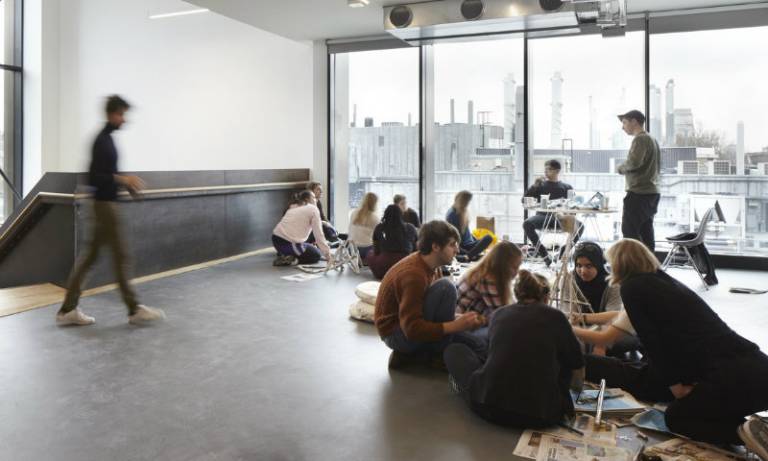Past students making space for the future
15 February 2017
Two top architects (and former UCL students) share their involvement in shaping new teaching spaces at UCL.

One objective of UCL’s Education Strategy is to create a teaching estate that meets our needs, recognising that the quality of the teaching estate, and the way we use it, can make a big difference to staff and students – facilitating great teaching and ensuring students are learning in comfortable, well-equipped and inspiring spaces.
Two alumni of the Bartlett School of Architecture are working on projects under Transforming UCL, the largest capital programme in the university’s history, where over £1.2 billion will be invested over the next 10 years. Their experience of studying at UCL has informed their approach to the design of the new spaces.
James Eades (Architecture 1996) is working on the New Student Centre, UCL’s flagship development which will transform the UCL student experience and put students at the core of our mission as a world-leading university.
The New Student Centre is part of the university’s masterplan for the long-term future of its Bloomsbury campus at a time when it is also planning an east London campus. The space will provide learning and support facilities, a cafe, and space for exhibitions as well as 1,000 study spaces and an enquiries centre
“The building has been designed to promote unexpected interactions, collaborations, mingling and serendipitous moments,” says James Eades, partner at Nicholas Hare Architects. “There will be informal, flexible spaces, quiet spaces, social spaces – places to go with friends to talk through ideas and places to go and get your head down. There won’t be teaching spaces and there won’t be books – although there will be computers, as students told us they didn’t always want to carry a laptop.”
The learning spaces will vary in character and size, creating different types of individual study and group environments. None of the spaces will be used for formal teaching. At the heart of the building an enormous atrium will draw students up to the more enclosed floors and provide a constant, clear point of orientation. “Around the new atrium there will be informal sitting spaces to read for five minutes and on the street side there will be rooms for private study, with carpets for softness and quiet.”
Physically, the new building will complete the quad already partly formed by the Wilkins and Bernard Katz buildings, transforming the gateway to campus and creating a new front door on Gordon Street.
Tom Noonan (Architecture 2010) has been working as Project Architect and Associate on a number of UCL building projects since 2012, notably 22 Gordon Street, the new home for The Bartlett School of Architecture. An Associate at Hawkins\Brown Architects, he graduated from UCL Bartlett School of Architecture in 2010 with a Master’s degree in Architecture.
Tom says: "Studying architecture is a unique experience and the ‘studio’ can often become your home for a number of years. Many students can spend over 12 hours a day, 7 days a week in an environment that can sometimes feel like anything but home. The old Wates House building was in poor condition, insular, stuffy and dark, and the cellular layout did not encourage dialogue between the studio units. There was very limited breakout or social space and nowhere for any respite from the intensity of the studios."
Central to the design philosophy behind 22 Gordon Street is the idea of connectivity - between students, staff and the public and the city beyond. This has been achieved by opening up the façade with large windows, placing exhibition spaces at ground floor level, inserting a new ‘social’ staircase to open up the building’s circulation, re-orientating the entrance and expressing key spaces to give strategic views of London. Another key driver for the design is adaptability - whilst the new building has been specifically designed to the unique pedagogy and context of The Bartlett, it has also been designed to allow reconfiguration that can respond to the constantly changing world of architecture and higher education.
Tom says: "The new building works very hard to eke out as much ‘humane’ space as possible. The entire building has been reconfigured to include significantly more studios, breakout and office space, encouraging collaboration across the school. Our design also doubles the amount of teaching and research space, all while retaining the building’s existing structure.
"At The Bartlett I learned to be inquisitive and to listen, which is something that I have tried to take forward into professional practice. Across all the UCL projects, we have encouraged a wide range of collaborative consultations and design reviews - with building users and wider stakeholders - which have been very similar to The Bartlett ‘crit’ – a pin-up and presentation in front of a panel of critics, which can be one of the most terrifying but inspiring experiences of architectural education.
"It was a real joy returning to 22 Gordon Street during the first week of opening, to watch the return of students with big smiles on their faces! Each time I have been there since, I have been surprised by how the students have started to inhabit their new spaces - the studios are filled with models and drawings, classical music played on a second hand piano permeates through the new breakout spaces, 100 students using the new gallery space to intricately cut-out thousands of paper buildings, which were later composed into an imaginary city on the wall… The conversations I have had with students and alumni have been overwhelmingly positive and I can’t wait to see what happens over the next weeks, months and years to come."
 Close
Close

